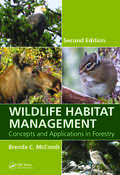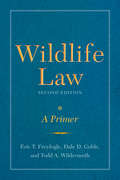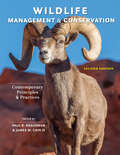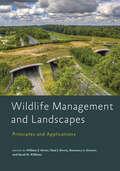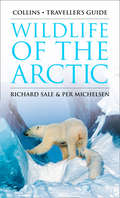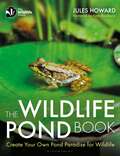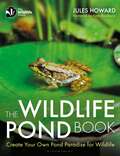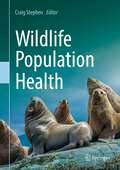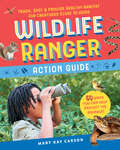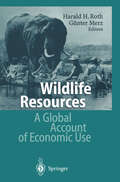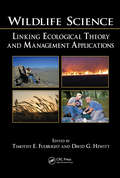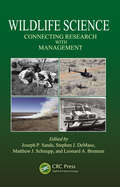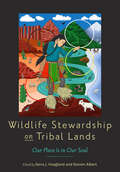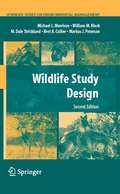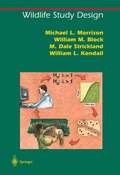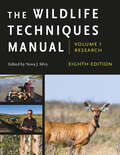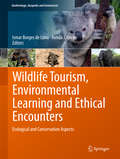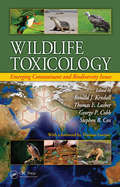- Table View
- List View
Wildlife Habitat Management: Concepts and Applications in Forestry, Second Edition
by Brenda C. McCombShortlisted for the 2018 TWS Wildlife Publication Awards in the authored book categoryIn recent years, conflicts between ecological conservation and economic growth forced a reassessment of the motivations and goals of wildlife and forestry management. Focus shifted from game and commodity management to biodiversity conservation and ecological fore
Wildlife in Airport Environments: Preventing Animal–Aircraft Collisions through Science-Based Management (Wildlife Management and Conservation)
by Travis L. DeVault Jerrold L. Belant Bradley F. BlackwellThe pilot watches the instrument panel and prepares for touchdown—a routine landing until a burst of birds, a coyote, or a herd of deer crosses the runway! Every year, pilots experience this tension and many aircraft come into direct contact with birds and other wildlife, resulting in more than one billion dollars in damage annually. The United States Federal Aviation Administration has recorded a rise in these incidents over the past decade due to the combined effects of more reporting, rebounding wildlife populations, and an increased number of flights. Wildlife in Airport Environments tackles the issue of what to do about encounters with wildlife in and around airports—from rural, small-craft airparks to major international hubs. Whether the problem is birds or bats in the flight path or a moose on the runway, the authors provide a thorough overview of the science behind wildlife management at airports. This well-written, carefully documented volume presents a clear synthesis for researchers, wildlife managers, and airport professionals. The book belongs in the hands of all those charged with minimizing the risks that wildlife pose to air travel.Wildlife in Airport Environments is the first book in the series Wildlife Management and Conservation and is published in association with The Wildlife Society.ContributorsMichael L. Avery, U.S. Department of AgricultureJerrold L. Belant, Mississippi State UniversityKristin M. Biondi, Mississippi State UniversityBradley F. Blackwell, U.S. Department of AgricultureJonathon D. Cepek, U.S. Department of AgricultureLarry Clark, U.S. Department of AgricultureTara J. Conkling, Mississippi State UniversityScott R. Craven, University of Wisconsin–MadisonPaul D. Curtis, Cornell UniversityTravis L. DeVault, U.S. Department of AgricultureRichard A. Dolbeer, U.S. Department of AgricultureDavid Felstul, U.S. Department of the InteriorEsteban Fernández-Juricic, Purdue UniversityAlan B. Franklin, U.S. Department of AgricultureSidney A. Gauthreaux Jr., Clemson UniversityMichael Lavelle, U.S. Department of AgricultureJames A. Martin, Mississippi State UniversityRebecca Mihalco, U.S. Department of AgriculturePaige M. Schmidt, U.S. Fish and Wildlife ServiceThomas W. Seamans, U.S. Department of AgricultureKurt C. VerCauteren, U.S. Department of AgricultureBrian E. Washburn, U.S. Department of Agriculture
Wildlife in Airport Environments: Preventing Animal–Aircraft Collisions through Science-Based Management (Wildlife Management and Conservation)
by Travis L. DeVault Bradley F. Blackwell Jerrold L. BelantThe pilot watches the instrument panel and prepares for touchdown—a routine landing until a burst of birds, a coyote, or a herd of deer crosses the runway! Every year, pilots experience this tension and many aircraft come into direct contact with birds and other wildlife, resulting in more than one billion dollars in damage annually. The United States Federal Aviation Administration has recorded a rise in these incidents over the past decade due to the combined effects of more reporting, rebounding wildlife populations, and an increased number of flights. Wildlife in Airport Environments tackles the issue of what to do about encounters with wildlife in and around airports—from rural, small-craft airparks to major international hubs. Whether the problem is birds or bats in the flight path or a moose on the runway, the authors provide a thorough overview of the science behind wildlife management at airports. This well-written, carefully documented volume presents a clear synthesis for researchers, wildlife managers, and airport professionals. The book belongs in the hands of all those charged with minimizing the risks that wildlife pose to air travel.Wildlife in Airport Environments is the first book in the series Wildlife Management and Conservation and is published in association with The Wildlife Society.ContributorsMichael L. Avery, U.S. Department of AgricultureJerrold L. Belant, Mississippi State UniversityKristin M. Biondi, Mississippi State UniversityBradley F. Blackwell, U.S. Department of AgricultureJonathon D. Cepek, U.S. Department of AgricultureLarry Clark, U.S. Department of AgricultureTara J. Conkling, Mississippi State UniversityScott R. Craven, University of Wisconsin–MadisonPaul D. Curtis, Cornell UniversityTravis L. DeVault, U.S. Department of AgricultureRichard A. Dolbeer, U.S. Department of AgricultureDavid Felstul, U.S. Department of the InteriorEsteban Fernández-Juricic, Purdue UniversityAlan B. Franklin, U.S. Department of AgricultureSidney A. Gauthreaux Jr., Clemson UniversityMichael Lavelle, U.S. Department of AgricultureJames A. Martin, Mississippi State UniversityRebecca Mihalco, U.S. Department of AgriculturePaige M. Schmidt, U.S. Fish and Wildlife ServiceThomas W. Seamans, U.S. Department of AgricultureKurt C. VerCauteren, U.S. Department of AgricultureBrian E. Washburn, U.S. Department of Agriculture
Wildlife Law: A Primer
by Eric T. Freyfogle Dale D. Goble Todd A. WildermuthTen years ago, Wildlife Law: A Primer was the first‑ever published survey of wildlife law for lay readers. Since its publication, the legal terrain has increased in complexity and the stakes are higher than ever. As humans encroach further into wildlife habitat, unwanted human‑wildlife interactions are occurring more frequently, sometimes with alarming and tragic outcomes. This revised and expanded second edition retains basic legal concepts from the first edition while offering new chapters that cover new controversial topics such as private wildlife reserves, game ranches, and nuisance species. It also includes expanded coverage of the Endangered Species Act. This is a groundbreaking reference for students in wildlife programs, land owners, and wildlife professionals.
Wildlife Management and Conservation: Contemporary Principles and Practices
by Paul R. Krausman And James W. Cain IIIThe definitive textbook for students of wildlife management, now updated to cover the latest techniques, tools, and topics.Wildlife Management and Conservation presents a clear overview of the management and conservation of animals, their habitats, and how people influence both. The relationship among these three components of wildlife management is explained in chapters written by leading experts and is designed to prepare students for careers in which they will be charged with maintaining healthy animal populations. To be successful wildlife professionals, they will need to find ways to restore depleted populations, reduce overabundant, introduced, or pest species, and manage relationships among various human stakeholders. This book gives them the basic knowledge necessary to accomplish these goals.This second edition, which is updated throughout, features several new and expanded topics, including communication in the wildlife profession, fire science, Indigenous models of management and conservation, plant–animal interactions, quantitative analysis of wildlife populations, and a detailed glossary. The book also covers:• Human dimensions of wildlife management• Animal behavior• Predator–prey relationships• Structured decision making• Issues of scale in wildlife management• Wildlife health• Historical context of wildlife management and conservation• Hunting and trapping• Nongame species• Nutrition ecology• Water management• Climate change• Conservation planningThe most widely used foundational text in the field, this is the perfect resource not only for students but also for early career professionals and those in related fields who need to understand the core tenets and tools of wildlife conservation and management.Contributors: C. Jane Anderson, Bart M. Ballard, Warren B. Ballard, John A. Bissonette, Clint Boal, Scott B. Boyle, Leonard A. Brennan, Robert D. Brown, James W. Cain III, Tyler A. Campbell, Michael J. Cherry, Michael R. Conover, Daniel J. Decker, Randall W. DeYoung, Jonathan B. Dinkins, W. Sue Fairbanks, Selma N. Glasscock, James B. Grand, Michael J. Haney, James R. Heffelfinger, Scott E. Henke, Fidel Hernandez, Davie G. Hewitt, C. L. Hoving, David A. Jessup, Heather E. Johnson, Winifred B. Kessler, John L. Koprowski, Paul R. Krausman, William P. Kuvlesky, Jr., Roel R. Lopez, R. W. Mannan, Scott Mills, Michael S. Mitchell, Michael L. Morrison, Anna M. Muñoz, John F. Organ, Katherine L. Parker, William F. Porter, Shawn J. Riley, Steven S. Rosenstock, Michael C. Runge, Susan P. Rupp, William F. Siemer, Robert J. Steidl, Kelley M. Stewart
Wildlife Management and Conservation: Contemporary Principles and Practices (Wildlife Management And Conservation Ser.)
by Paul R. Krausman James W. Cain IIIWildlife Management and Conservation presents a clear overview of the management and conservation of animals, their habitats, and how people influence both. The relationship among these three components of wildlife management is explained in chapters written by leading experts and is designed to prepare wildlife students for careers in which they will be charged with maintaining healthy animal populations; finding ways to restore depleted populations while reducing overabundant, introduced, or pest species; and managing relationships among various human stakeholders.Topics covered in this book include• The definitions of wildlife and management• Human dimensions of wildlife management• Animal behavior• Predator–prey relationships • Structured decision making• Issues of scale in wildlife management• Wildlife health• Historical context of wildlife management and conservation• Hunting and trapping• Nongame species• Nutrition ecology• Water management• Climate change• Conservation planning
Wildlife Management and Conservation: Contemporary Principles and Practices
by Paul R. Krausman James W. CainWildlife Management and Conservation presents a clear overview of the management and conservation of animals, their habitats, and how people influence both. The relationship among these three components of wildlife management is explained in chapters written by leading experts and is designed to prepare wildlife students for careers in which they will be charged with maintaining healthy animal populations; finding ways to restore depleted populations while reducing overabundant, introduced, or pest species; and managing relationships among various human stakeholders.Topics covered in this book include• The definitions of wildlife and management• Human dimensions of wildlife management• Animal behavior• Predator–prey relationships • Structured decision making• Issues of scale in wildlife management• Wildlife health• Historical context of wildlife management and conservation• Hunting and trapping• Nongame species• Nutrition ecology• Water management• Climate change• Conservation planning
Wildlife Management and Conservation: Contemporary Principles and Practices
by Paul R. Krausman James W. CainThe definitive textbook for students of wildlife management, now updated to cover the latest techniques, tools, and topics.Wildlife Management and Conservation presents a clear overview of the management and conservation of animals, their habitats, and how people influence both. The relationship among these three components of wildlife management is explained in chapters written by leading experts and is designed to prepare students for careers in which they will be charged with maintaining healthy animal populations. To be successful wildlife professionals, they will need to find ways to restore depleted populations, reduce overabundant, introduced, or pest species, and manage relationships among various human stakeholders. This book gives them the basic knowledge necessary to accomplish these goals.This second edition, which is updated throughout, features several new and expanded topics, including communication in the wildlife profession, fire science, Indigenous models of management and conservation, plant–animal interactions, quantitative analysis of wildlife populations, and a detailed glossary. The book also covers:• Human dimensions of wildlife management• Animal behavior• Predator–prey relationships• Structured decision making• Issues of scale in wildlife management• Wildlife health• Historical context of wildlife management and conservation• Hunting and trapping• Nongame species• Nutrition ecology• Water management• Climate change• Conservation planningThe most widely used foundational text in the field, this is the perfect resource not only for students but also for early career professionals and those in related fields who need to understand the core tenets and tools of wildlife conservation and management.Contributors: C. Jane Anderson, Bart M. Ballard, Warren B. Ballard, John A. Bissonette, Clint Boal, Scott B. Boyle, Leonard A. Brennan, Robert D. Brown, James W. Cain III, Tyler A. Campbell, Michael J. Cherry, Michael R. Conover, Daniel J. Decker, Randall W. DeYoung, Jonathan B. Dinkins, W. Sue Fairbanks, Selma N. Glasscock, James B. Grand, Michael J. Haney, James R. Heffelfinger, Scott E. Henke, Fidel Hernandez, Davie G. Hewitt, C. L. Hoving, David A. Jessup, Heather E. Johnson, Winifred B. Kessler, John L. Koprowski, Paul R. Krausman, William P. Kuvlesky, Jr., Roel R. Lopez, R. W. Mannan, Scott Mills, Michael S. Mitchell, Michael L. Morrison, Anna M. Muñoz, John F. Organ, Katherine L. Parker, William F. Porter, Shawn J. Riley, Steven S. Rosenstock, Michael C. Runge, Susan P. Rupp, William F. Siemer, Robert J. Steidl, Kelley M. Stewart
Wildlife Management and Landscapes: Principles and Applications (Wildlife Management and Conservation)
by William F. Porter Chad J. Parent Rosemary A. Stewart David M. WilliamsWildlife management specialists and landscape ecologists offer a new perspective on the important intersection of these fields in the twenty-first century.It's been clear for decades that landscape-level patterns and processes, along with the tenets and tools of landscape ecology, are vitally important in understanding wildlife-habitat relationships and sustaining wildlife populations. Today, significant shifts in the spatial scale of extractive, agricultural, ranching, and urban land uses are upon us, making it more important than ever before to connect wildlife management and landscape ecology. Landscape ecologists must understand the constraints that wildlife managers face and be able to use that knowledge to translate their work into more practical applications. Wildlife managers, for their part, can benefit greatly from becoming comfortable with the vocabulary, conceptual processes, and perspectives of landscape ecologists.In Wildlife and Landscapes, the foremost landscape ecology experts and wildlife management specialists come together to discuss the emerging role of landscape concepts in habitat management. Their contributions• make the case that a landscape perspective is necessary to address management questions• translate concepts in landscape ecology to wildlife management• explain why studying some important habitat-wildlife relationships is still inherently difficult• explore the dynamic and heterogeneous structure of natural systems• reveal why factors such as soil, hydrology, fire, grazing, and timber harvest lead to uncertainty in management decisions• explain matching scale between population processes and management• discuss limitations to management across jurisdictional boundaries and balancing objectives of private landowners and management agencies• offer practical ideas for improving communication between professionals• outline the impediments that limit a full union of landscape ecology and wildlife managementUsing concrete examples of modern conservation challenges that range from oil and gas development to agriculture and urbanization, the volume posits that shifts in conservation funding from a hunter constituent base to other sources will bring a dramatic change in the way we manage wildlife. Explicating the foundational similarity of wildlife management and landscape ecology, Wildlife and Landscapes builds crucial bridges between theoretical and practical applications.Contributors: Jocelyn L. Aycrigg, Guillaume Bastille-Rousseau, Jon P. Beckmann, Joseph R. Bennett, William M. Block, Todd R. Bogenschutz, Teresa C. Cohn, John W. Connelly, Courtney J. Conway, Bridgett E. Costanzo, David D. Diamond, Karl A. Didier, Lee F. Elliott, Michael E. Estey, Lenore Fahrig, Cameron J. Fiss, Jacqueline L. Frair, Elsa M. Haubold, Fidel Hernández, Jodi A. Hilty, Joseph D. Holbrook, Cynthia A. Jacobson, Kevin M. Johnson, Jeffrey K. Keller, Jeffery L. Larkin, Kimberly A. Lisgo, Casey A. Lott, Amanda E. Martin, James A. Martin, Darin J. McNeil, Michael L. Morrison, Betsy E. Neely, Neal D. Niemuth, Chad J. Parent, Humberto L. Perotto-Baldivieso, Ronald D. Pritchert, Fiona K. A. Schmiegelow, Amanda L. Sesser, Gregory J. Soulliere, Leona K. Svancara, Stephen C. Torbit, Joseph A. Veech, Kerri T. Vierling, Greg Wathen, David M. Williams, Mark J. Witecha, John M. Yeiser
Wildlife Management and Landscapes: Principles and Applications (Wildlife Management and Conservation)
by William F. Porter, Chad J. Parent, Rosemary A. Stewart and David M. WilliamsWildlife management specialists and landscape ecologists offer a new perspective on the important intersection of these fields in the twenty-first century.It's been clear for decades that landscape-level patterns and processes, along with the tenets and tools of landscape ecology, are vitally important in understanding wildlife-habitat relationships and sustaining wildlife populations. Today, significant shifts in the spatial scale of extractive, agricultural, ranching, and urban land uses are upon us, making it more important than ever before to connect wildlife management and landscape ecology. Landscape ecologists must understand the constraints that wildlife managers face and be able to use that knowledge to translate their work into more practical applications. Wildlife managers, for their part, can benefit greatly from becoming comfortable with the vocabulary, conceptual processes, and perspectives of landscape ecologists.In Wildlife and Landscapes, the foremost landscape ecology experts and wildlife management specialists come together to discuss the emerging role of landscape concepts in habitat management. Their contributions• make the case that a landscape perspective is necessary to address management questions• translate concepts in landscape ecology to wildlife management• explain why studying some important habitat-wildlife relationships is still inherently difficult• explore the dynamic and heterogeneous structure of natural systems• reveal why factors such as soil, hydrology, fire, grazing, and timber harvest lead to uncertainty in management decisions• explain matching scale between population processes and management• discuss limitations to management across jurisdictional boundaries and balancing objectives of private landowners and management agencies• offer practical ideas for improving communication between professionals• outline the impediments that limit a full union of landscape ecology and wildlife managementUsing concrete examples of modern conservation challenges that range from oil and gas development to agriculture and urbanization, the volume posits that shifts in conservation funding from a hunter constituent base to other sources will bring a dramatic change in the way we manage wildlife. Explicating the foundational similarity of wildlife management and landscape ecology, Wildlife and Landscapes builds crucial bridges between theoretical and practical applications.Contributors: Jocelyn L. Aycrigg, Guillaume Bastille-Rousseau, Jon P. Beckmann, Joseph R. Bennett, William M. Block, Todd R. Bogenschutz, Teresa C. Cohn, John W. Connelly, Courtney J. Conway, Bridgett E. Costanzo, David D. Diamond, Karl A. Didier, Lee F. Elliott, Michael E. Estey, Lenore Fahrig, Cameron J. Fiss, Jacqueline L. Frair, Elsa M. Haubold, Fidel Hernández, Jodi A. Hilty, Joseph D. Holbrook, Cynthia A. Jacobson, Kevin M. Johnson, Jeffrey K. Keller, Jeffery L. Larkin, Kimberly A. Lisgo, Casey A. Lott, Amanda E. Martin, James A. Martin, Darin J. McNeil, Michael L. Morrison, Betsy E. Neely, Neal D. Niemuth, Chad J. Parent, Humberto L. Perotto-Baldivieso, Ronald D. Pritchert, Fiona K. A. Schmiegelow, Amanda L. Sesser, Gregory J. Soulliere, Leona K. Svancara, Stephen C. Torbit, Joseph A. Veech, Kerri T. Vierling, Greg Wathen, David M. Williams, Mark J. Witecha, John M. Yeiser
Wildlife of the Arctic (Traveller’s Guide)
by Richard SaleThis book celebrates the Arctic, exploring the natural history that has so inspired generations.
The Wildlife Pond Book: Create Your Own Pond Paradise for Wildlife (The Wildlife Trusts)
by Jules HowardPonds are vital oases for nature. They are nursery grounds, feeding stops and bathing spots. They are genetic superhighways and vibrant ecosystems each brimming with life, interactions and potential. And they are for everyone.In The Wildlife Pond Book, Jules Howard offers a fresh perspective on ponds and encourages gardeners to reach for a garden spade and do something positive to benefit our shared neighbourhood nature.As well as offering practical tips and advice on designing, planting up and maintaining your pond, Jules encourages readers to explore the wildlife that colonises it with a torch, a microscope or a good old-fashioned pond-dipping net.With a foreword by award-winning wildlife-gardening author, Kate Bradbury, this helpful new guide includes a section outlining the hundreds of organisms that may turn up in your pond and is packed with creative ideas that have been tried and tested by author Jules Howard, an avid pond-builder, prolific pond-dipper and passionate voice for freshwater conservation for more than fifteen years.So, no matter how big your outdoor space is, The Wildlife Pond Book is the guide you need to create your very own haven for nature.
The Wildlife Pond Book: Create Your Own Pond Paradise for Wildlife (The Wildlife Trusts)
by Jules HowardPonds are vital oases for nature. They are nursery grounds, feeding stops and bathing spots. They are genetic superhighways and vibrant ecosystems each brimming with life, interactions and potential. And they are for everyone.In The Wildlife Pond Book, Jules Howard offers a fresh perspective on ponds and encourages gardeners to reach for a garden spade and do something positive to benefit our shared neighbourhood nature.As well as offering practical tips and advice on designing, planting up and maintaining your pond, Jules encourages readers to explore the wildlife that colonises it with a torch, a microscope or a good old-fashioned pond-dipping net.With a foreword by award-winning wildlife-gardening author, Kate Bradbury, this helpful new guide includes a section outlining the hundreds of organisms that may turn up in your pond and is packed with creative ideas that have been tried and tested by author Jules Howard, an avid pond-builder, prolific pond-dipper and passionate voice for freshwater conservation for more than fifteen years.So, no matter how big your outdoor space is, The Wildlife Pond Book is the guide you need to create your very own haven for nature.
Wildlife Population Health
by Craig StephenThis textbook introduces the core competencies, tools and perspectives to manage free-ranging animal population health and demonstrates their need and relevance to help wildlife cope with the ever-increasing pressures of the Anthropocene, manifested by global megatrends such as climate change, urbanization and pollution. It adapts and adopts key concepts of population health from public health and herd health to a wildlife health context. In a highly-accessible and unique form, this book presents a modern way of approaching wildlife and fish epidemiology, health promotion and disease control, with a focus on the social dimensions of wildlife health management. Aimed at graduate students in veterinary medicine, wildlife researchers and health managers this textbook provides a valuable source of information to foster the knowledge and skills needed to protect and promote the health of free-ranging wildlife.
Wildlife Ranger Action Guide: Track, Spot & Provide Healthy Habitat for Creatures Close to Home
by Mary Kay CarsonWith hands-on projects, activities, and a wildlife field guide, kids discover how they can identify, attract, and protect habitat for bees, butterflies, and wild animals living right around them.
Wildlife Resources: A Global Account of Economic Use
by Harald H. RothThe general interest and attention paid to the use of the renewable natural resources of the world have increased greatly during the last decades. This is due to the environmental dilemma into which mankind has got itself by the total disregard of ecological facts and laws, the underprizing of natural resources and the overemphasis on economic develop ment, coupled with unimpeded rapid population growth and the preponderance of material istic consumption-oriented attitudes. The management and use of natural resources such as forests, grasslands, rivers and lakes were formerly considered purely in a financial context, whereas latterly, a consciousness of their social function and the indirect economic benefits which can be derived from them has developed. Thus, as regards these traditional resources, multi-use concepts comprising eco nomically oriented utilisation as well as recreational, educational and social use have be come widely accepted. Conservation of natural resources for sustainable consumptive as well as non-consumptive uses has been recognised as a key element for maintaining eco nomic development all over the world. Fortunately, the industrialised countries have started to apply this principle themselves and in their technical and financial aid to the developing Third World countries. This is manifest from policy documents such as the World Bank Policy on Development of Wild Lands, issued in 1987.
Wildlife Science: Linking Ecological Theory and Management Applications
by Timothy E. Fulbright David G. HewittConsciously or not, wildlife managers generally act from a theoretical basis, although they may not be fully versed in the details or ramifications of that theory. In practice, the predictions of the practitioners sometimes prove more accurate than those of the theoreticians. Practitioners and theoreticians need to work together, but this proves di
Wildlife Science: Connecting Research with Management
by Joseph P. Sands Leonard A. Brennan Stephen J. DeMaso Matthew J. SchnuppDespite the potential synergy that can result from basing management applications on results from research, there is a polarization of cultures between wildlife managers and wildlife researchers. Wildlife Science: Connecting Research with Management provides strategies for bridging cultural and communication gaps between these groups.Contributors p
Wildlife Stewardship on Tribal Lands: Our Place Is in Our Soul
by Serra J. Hoagland Steven AlbertThis groundbreaking book brings together Native American and Indigenous scholars, wildlife managers, legal experts, and conservationists from dozens of tribes to share their wildlife stewardship philosophies, histories, principles, and practices.Tribes have jurisdiction over some of the healthiest wild areas in North America, collectively managing over 56 million acres of land. This is no accident: in addition to a deep reverence for the land and a strong history of environmental stewardship, Native peoples implement some of the best fish and wildlife preservation and management practices on the continent. Wildlife Stewardship on Tribal Lands is the first comprehensive resource dedicated to the voices and expertise of Native scholars and wildlife professionals. In its pages, nearly one hundred Native and non-native wildlife conservationists, managers, and their collaborators share lessons to guide wildlife professionals in how best to incorporate native methods and how to work effectively with tribal stakeholders. The authors cover topics that include:• Guidelines for conducting research on tribal lands• Traditional ecological knowledge-based management models• The cultural and ecological importance of key species• Legal battles for treaty rights, management authority, and funding• First foods and food sovereignty • Fisheries and migratory bird management• Tribal perspectives on the Endangered Species Act• A history of modern fish and wildlife management on tribal landsThe content of this book is not limited to the invaluable reports of research findings, explications of methodologies, and case studies. Capturing oral histories and spiritual knowledge through interviews with tribal leaders and the work of Native artists and writers honors the holistic awareness of the land offered to readers of this unique volume. Ultimately, the contributors to Wildlife Stewardship on Tribal Lands demonstrate how tribal practices are pivotal guideposts for those seeking to protect and harness our natural resources in ways that can help reverse grievous biodiversity losses and ensure the health of our environment for future generations.Contributors: Scott Aikin, Steven Albert, John Antonio, Dale Becker, Bethany Berger, Kimberly Blaeser, Arthur Blazer, Michael Blumm, Michael Brydge, Ashley Carlisle, Frank Cerno Jr., Sally Carufel Williams, Guy Charlton, Samuel Chischilly, Bob Christensen, Gerald Cobell, Cody Desautel, Lauren Divine, Douglas W. Dompier, Ramona Emerson, Kari Eneas, James Fall, Julian J. Fischer, James R. Floyd, James Gensaw Sr., Michael I. Goldstein, Kim Gottschalk, Shaun Grassel, E. Richard Hart, Dylan R. Hedden-Nicely, Caleb Hickman, Serra J. Hoagland, Kraig Holmes, Nathan Jim, R. Roy Johnson, Jovon Jojola, Tamra Jones, Emily Sylvan Kim, Winona LaDuke, Stacy Leeds, Crystal Leonetti, Aaron P. Lestenkof, Chip Livingston, Lorraine Marquez Eiler, Eric Mellink, Paul I. Melovidov, Lara Mengak, Gary Paul Nabhan, Liliana Naves, Vern Northrup, nila northSun, Raymond E. Paddock III, Lizzy Pennock, Nicole Marie Pete, Aaron Poe, Georgiana Pongyesva, Ken Poynter, Mathis Quintana, Seafha Ramos, Janisse Ray, Vanessa L. Ray-Hodge, Amadeo Rea, Mitzi Reed, Marcie Rendon, Sarah F. Rinkevich, Bruce Robson, Andrea Rogers, Thomas C. Rothe, David E. Safine, Patty Schwalenberg, Kyle Secakuku, John Sewall, Todd Sformo, Richard T. Sherman, Ron Skates, Arthur M. Soukkala, Lawrence Stevens, Juliana Suzukawa, Julie Thorstenson, Gloria Tom, Christopher Tran, Craig van der Heiden, John Wheeler, Jessica Wiarda, Tiana Williams-Claussen.
Wildlife Stewardship on Tribal Lands: Our Place Is in Our Soul
by Serra J. Hoagland and Steven AlbertThis groundbreaking book brings together Native American and Indigenous scholars, wildlife managers, legal experts, and conservationists from dozens of tribes to share their wildlife stewardship philosophies, histories, principles, and practices.Tribes have jurisdiction over some of the healthiest wild areas in North America, collectively managing over 56 million acres of land. This is no accident: in addition to a deep reverence for the land and a strong history of environmental stewardship, Native peoples implement some of the best fish and wildlife preservation and management practices on the continent. Wildlife Stewardship on Tribal Lands is the first comprehensive resource dedicated to the voices and expertise of Native scholars and wildlife professionals. In its pages, nearly one hundred Native and non-native wildlife conservationists, managers, and their collaborators share lessons to guide wildlife professionals in how best to incorporate native methods and how to work effectively with tribal stakeholders. The authors cover topics that include:• Guidelines for conducting research on tribal lands• Traditional ecological knowledge-based management models• The cultural and ecological importance of key species• Legal battles for treaty rights, management authority, and funding• First foods and food sovereignty • Fisheries and migratory bird management• Tribal perspectives on the Endangered Species Act• A history of modern fish and wildlife management on tribal landsThe content of this book is not limited to the invaluable reports of research findings, explications of methodologies, and case studies. Capturing oral histories and spiritual knowledge through interviews with tribal leaders and the work of Native artists and writers honors the holistic awareness of the land offered to readers of this unique volume. Ultimately, the contributors to Wildlife Stewardship on Tribal Lands demonstrate how tribal practices are pivotal guideposts for those seeking to protect and harness our natural resources in ways that can help reverse grievous biodiversity losses and ensure the health of our environment for future generations.Contributors: Scott Aikin, Steven Albert, John Antonio, Dale Becker, Bethany Berger, Kimberly Blaeser, Arthur Blazer, Michael Blumm, Michael Brydge, Ashley Carlisle, Frank Cerno Jr., Sally Carufel Williams, Guy Charlton, Samuel Chischilly, Bob Christensen, Gerald Cobell, Cody Desautel, Lauren Divine, Douglas W. Dompier, Ramona Emerson, Kari Eneas, James Fall, Julian J. Fischer, James R. Floyd, James Gensaw Sr., Michael I. Goldstein, Kim Gottschalk, Shaun Grassel, E. Richard Hart, Dylan R. Hedden-Nicely, Caleb Hickman, Serra J. Hoagland, Kraig Holmes, Nathan Jim, R. Roy Johnson, Jovon Jojola, Tamra Jones, Emily Sylvan Kim, Winona LaDuke, Stacy Leeds, Crystal Leonetti, Aaron P. Lestenkof, Chip Livingston, Lorraine Marquez Eiler, Eric Mellink, Paul I. Melovidov, Lara Mengak, Gary Paul Nabhan, Liliana Naves, Vern Northrup, nila northSun, Raymond E. Paddock III, Lizzy Pennock, Nicole Marie Pete, Aaron Poe, Georgiana Pongyesva, Ken Poynter, Mathis Quintana, Seafha Ramos, Janisse Ray, Vanessa L. Ray-Hodge, Amadeo Rea, Mitzi Reed, Marcie Rendon, Sarah F. Rinkevich, Bruce Robson, Andrea Rogers, Thomas C. Rothe, David E. Safine, Patty Schwalenberg, Kyle Secakuku, John Sewall, Todd Sformo, Richard T. Sherman, Ron Skates, Arthur M. Soukkala, Lawrence Stevens, Juliana Suzukawa, Julie Thorstenson, Gloria Tom, Christopher Tran, Craig van der Heiden, John Wheeler, Jessica Wiarda, Tiana Williams-Claussen.
Wildlife Study Design (Springer Series on Environmental Management)
by Michael L. Morrison William M. Block M. Dale Strickland Bret A. Collier Markus J. PetersonWe developed the first edition of this book because we perceived a need for a compilation on study design with application to studies of the ecology, conser- tion, and management of wildlife. We felt that the need for coverage of study design in one source was strong, and although a few books and monographs existed on some of the topics that we covered, no single work attempted to synthesize the many facets of wildlife study design. We decided to develop this second edition because our original goal – synthesis of study design – remains strong, and because we each gathered a substantial body of new material with which we could update and expand each chapter. Several of us also used the first edition as the basis for workshops and graduate teaching, which provided us with many valuable suggestions from readers on how to improve the text. In particular, Morrison received a detailed review from the graduate s- dents in his “Wildlife Study Design” course at Texas A&M University. We also paid heed to the reviews of the first edition that appeared in the literature.
Wildlife Study Design (Springer Series on Environmental Management)
by Michael L. Morrison W.L. Kendall William M. Block M. Dale StricklandWildlife Study Design is a comprehensive guide to all aspects of study design. It including a survey of major types of studies and variables, impact assessment, sampling techniques, inventorying and monitoring, and analysis of data. The book includes a practical, step-by-step guide to setting up a new study. Minimal mathematical notation and examples drawn from field research make applied animal ecology both accessible and relevant. Resource managers, researchers, and students of wildlife and conservation biology will find this book a fundamental resource for implementing and evaluating appropriate studies.
The Wildlife Techniques Manual: Volume 1: Research. Volume 2: Management
by Nova J. SilvySince its original publication in 1960, The Wildlife Techniques Manual has remained the cornerstone text for the professional wildlife biologist. Now fully revised and updated, this eighth edition promises to be the most comprehensive resource on wildlife biology, conservation, and management for years to come. Superbly edited by Nova J. Silvy and published in association with The Wildlife Society, the 50 authoritative chapters included in this work provide a full synthesis of methods used in the field and laboratory. Chapter authors, all leading wildlife professionals, explain and critique traditional and new methodologies and offer thorough discussions of a wide range of relevant topics. To effectively incorporate the explosion of new information in the wildlife profession, this latest edition is logically organized into a 2-volume set: Volume 1 is devoted to research techniques and Volume 2 focuses on pragmatic management methodologies. Volume 1 describes research design and proper analytic methods prior to conducting research, as well as methods and considerations for capturing and handling wild animals and information on identification and marking of captured animals. It also includes new chapters on nutritional research and field sign identification, and on emerging topics, including structured decision-making. Finally, Volume 1 addresses measurements of wildlife abundance and habitat and research on individual animals. Volume 2 begins with a section on the relationship between research and management including public outreach, described in a context that encourages engagement prior to initiation of management. An adaptive management approach is described as a cornerstone of natural resource management, followed by a section on managing landscapes and wildlife populations. The volume also includes new chapters on ethics in wildlife science and conservation, conflict resolution and management, and land reclamation. A standard text in a variety of courses, the Techniques Manual, as it is commonly called, covers every aspect of modern wildlife management and provides practical information for applying the hundreds of methods described in its pages. This deft and thorough update ensures that The Wildlife Techniques Manual will remain an indispensable resource, one that professionals and students in wildlife biology, conservation, and management simply cannot do without.
Wildlife Tourism, Environmental Learning and Ethical Encounters: Ecological and Conservation Aspects (Geoheritage, Geoparks and Geotourism)
by Ismar Borges de Lima Ronda J. GreenThis book outlines the status quo of worldwide wildlife tourism and its impacts on planning, management, knowledge, awareness, behaviour and attitudes related to wildlife encounters. It sets out to fill the considerable gaps in our knowledge on wildlife tourism, applied ecology, and environmental education, providing comprehensive information on and an interdisciplinary approach to effective management in wildlife tourism. Examining the intricacies, challenges, and lessons learned in a meaningful and rewarding tourism niche, this interdisciplinary book comprehensively examines the major potentials and controversies in the wildlife tourism industry. Pursuing an insightful, provocative and hands-on approach, it primarily addresses two questions: ‘Can we reconcile the needs of the wildlife tourism industry, biodiversity conservation, ecological learning and animal ethics issues?’ and ‘What is the Future of the Wildlife Tourism Industry?’. Though primarily intended as a research text, it also offers a valuable resource for a broad readership, which includes university and training students, researchers, scholars, tourism practitioners and professionals, planners and managers, as well as the staff of government agencies.
Wildlife Toxicology: Emerging Contaminant and Biodiversity Issues
by Ronald J. Kendall Thomas E. Lacher George C. Cobb Stephen Boyd CoxUpdating the extremely successful Wildlife Toxicology and Population Modeling (CRC Press, 1994), Wildlife Toxicology: Emerging Contaminant and Biodiversity Issues brings together a distinguished group of international contributors, who provide a global assessment of a range of environmental stressors, including pesticides, environmental contaminant
